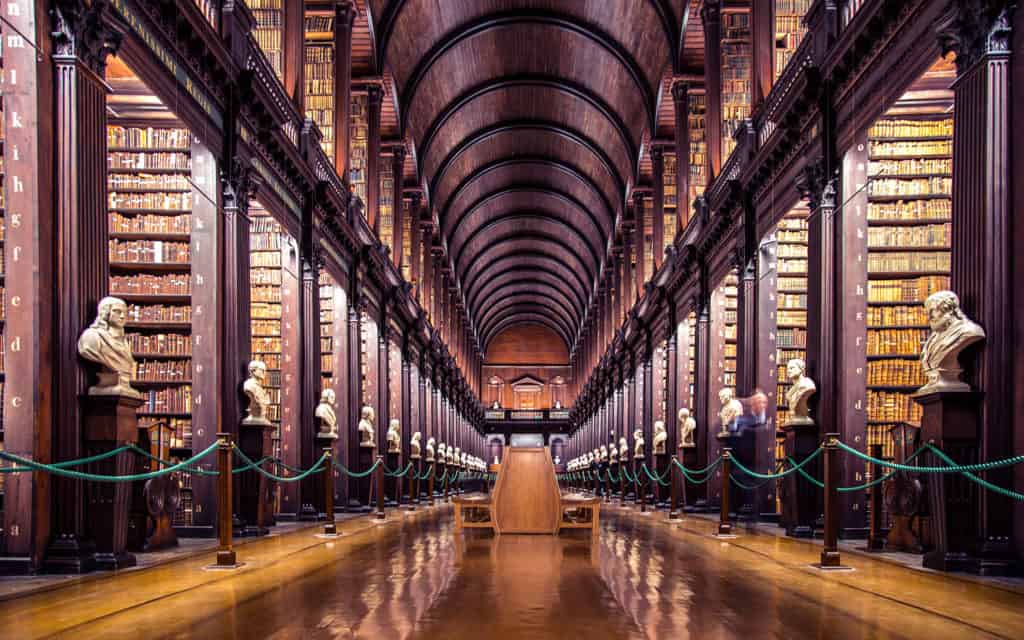Where cobbled streets lead to lively pubs, historic castles, and literary legends. From the hum of live music to the serenity of St. Stephen’s Green, it’s a city that’s best explored at its own pace, over a chat with a stranger, a slow pint in a snug, or a walk that somehow always leads to the Liffey.
Popular Experiences
Lesser known things to see & do
Seasonal activities
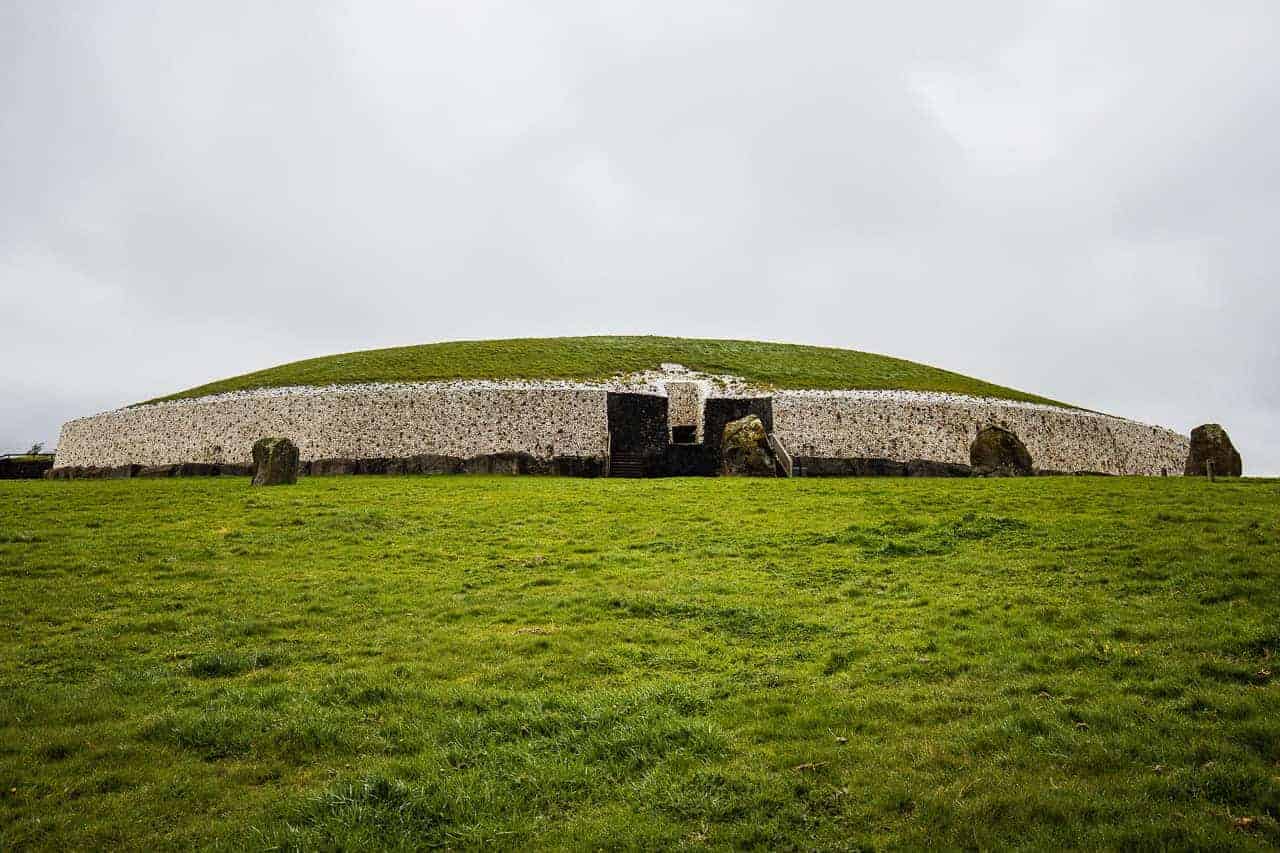
Focus on!
17 best day trips from Dublin to do independently or with a guide
If you’re visiting Dublin, there’s more to explore beyond the city. Some of Ireland’s best destinations are just a day trip away!
Places to Visit near Dublin
Dublin Travel Guide
Getting There – Travelling around – Where to Stay – What to do – Where to Eat – Practical Information – FAQ – All Blogs Articles
How to get to Dublin from abroad?
Dublin is well-connected to Europe Mainland and North America with its large international airport, from which several airlines fly in and out of the city. The Dublin Airport is located about 10 km north of the city centre and is the main gateway to Ireland.
Numerous direct flights are available from major cities in Europe and North America, with airlines such as Aer Lingus, Ryanair, British Airways, Emirates, and United Airlines.
For those travelling from the UK, ferry services such as Stena Line or Irish Ferries connect Dublin with ports in England and Wales.
There are no ferries to Dublin from mainland Europe, but a few companies operate from France and Spain to Rosslare in the south of Ireland. These ferry routes are quite long but perfect if you plan on driving your own car to visit Ireland.
What’s the best way to get to Dublin from Dublin Airport?
There are several ways to get to Dublin from Dublin Airport, depending on your preferences and budget.
One of the most popular options is to take a Shuttle bus, which offers direct service from the airport to the center of town with several stops along the way. Another option is to take a taxi or an Uber (operated by taxi drivers), which can be more expensive but also more convenient, especially if you have a lot of luggage or are in a hurry.
Dublin Express
The Dublin Express Airport shuttle (dark blue buses) operates bus services, stopping along the Liffey River to and from Heuston Station for €8 one way /€12 return. The journey time is approximately 25-40 minutes, and you can buy your ticket directly on the bus or book a trip online.
Aircoach
Aircoach (clear blue bus) also serves the city centre but continues south towards Lesson St, Sandyford, Greystones, and Killiney. They also have a few routes to Cork and Galway directly from/to the Dublin airport.
Go-Ahead Ireland
Go-ahead buses serve the northern part of Dublin, towards Sutton Dart Station or Balbriggan and Skerries.
Other ways of transport from Dublin Airport
There are no trains or trams from the airport. Alternatively, you can catch a taxi right outside the Arrival terminal. The fare meter is around €25-€35. Uber is also available from the airport, but be aware that in Ireland, Uber is operated by taxi companies anyway. It is, however, convenient to use Uber from or to Dublin Airport if you need an invoice or want to pay by card, as not all taxis accept card payment.
Alternatively, you can order a private transfer in advance to avoid queueing for a taxi or the stress and hassle of public transport. If you are keen to book a private transfer, have a look at this offer.
If you plan to visit only the city of Dublin during your stay in Ireland, we do not recommend renting a car. Check out this section for more details on how to travel around Dublin.
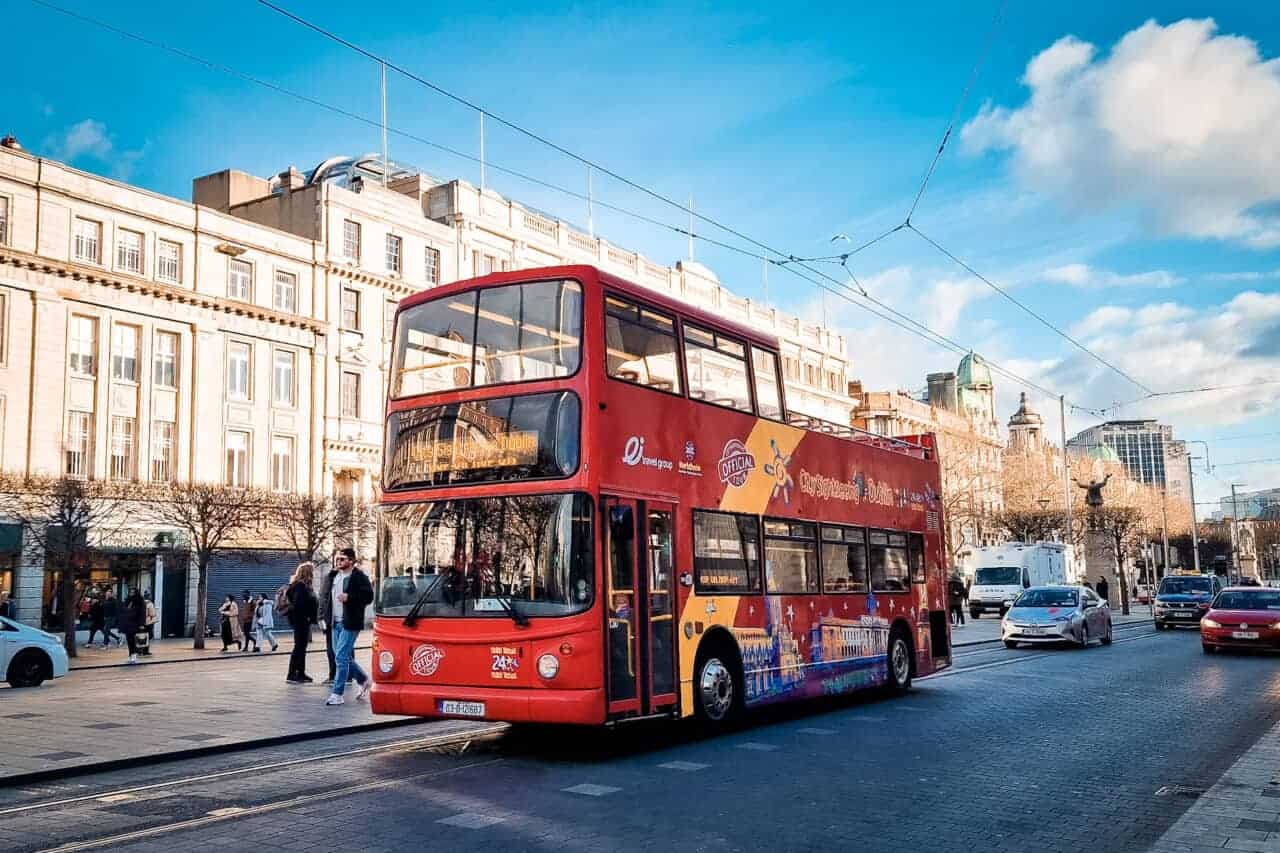
How to travel around Dublin?
Walk
Dublin is a very walkable city, and many of its attractions are within walking distance of each other. Several areas are pedestrian-only, including Parnel St., Temple Bar, and Grafton St.
Cycling
There are several Dublin bike-sharing schemes, such as the DublinBikes or Bleeper.
DublinBikes is a great way to explore the city on two wheels. There are over 100 stations throughout the city, and the first 30 minutes of each journey are free. To use the service, you need to set up an account online and download the app.
Apart from DublinBikes, another bike-sharing scheme is available in Dublin: Bleeper. Bleeper bikes are distinctive with their orange and white colour and operate in a slightly different way than DublinBikes. Bleeper bikes are dockless, meaning they can be left anywhere in the city, as long as it is a safe and legal spot. Users can find and unlock bikes using the Bleeper app, which allows easy payment.
There are also a few guided cycling tours that are worth looking into if that’s your type of fun! You can join this e-bike tour with a local guide, who will take you around the city with electric bikes and help you explore popular tourist attractions. It’s a fun way to see the city differently and learn about its history!
![]() Psst! Dublin has many cycling paths, but be extra vigilant with buses and pedestrians with whom you might share them. They don’t always look out for cyclists.
Psst! Dublin has many cycling paths, but be extra vigilant with buses and pedestrians with whom you might share them. They don’t always look out for cyclists.
Public Transport
Buses
Dublin’s public transportation system includes buses, trams, and trains. The most popular and convenient option is the Dublin Bus bus service. It operates an extensive network throughout the city and is the most affordable option for getting around. For more information, visit the DublinBus website.
Tram (Luas)
Dublin also has two Luas tram lines that provide quick and efficient travel around the city. The Green Line runs from Brides Glen in the city’s south to St. Stephen’s Green in the city centre and continues northbound to Broombridge. The Red Line runs from Tallaght in the southwest to The Point in the Docklands, with a branch to Dublin’s western suburbs of Saggart and Citywest.
Both lines intersect on O’Connell Street, which is quite central. Luas trams run frequently, with services every 3-15 minutes depending on the time of day, making them a great option for getting around Dublin quickly and conveniently. For more details, check out the Luas website.

Train (DART)
Additionally, there’s the DART (Dublin Area Rapid Transit) train service, which provides quick access to Dublin’s coastal towns. It runs along the coast from Malahide and Howth, north of Dublin, to Greystones in County Wicklow, just south of the city. The DART is a great way to explore the coastal areas outside the city, with stunning views of the sea and the cliffs along the way. It’s also a convenient way to get to popular tourist spots like Howth and Bray.
The DART runs frequently throughout the day, with trains arriving every 10-20 minutes, depending on the time of day. The cost of a DART ticket depends on the distance you are travelling, but it is usually affordable and offers a convenient way to get around the city and beyond. DART timetables and prices can be found here.
Get a Public Transport card
To use public transport in Dublin, you can take advantage of special fare options to make travelling around the city more convenient and affordable. One of the most popular options is the Leap Card, a rechargeable smart card that offers discounted fares on Dublin Bus, Luas, DART, and Commuter Rail services.
Another option is the Leap Card Visitor, which offers unlimited travel on Dublin Bus, Luas, DART, and Commuter Rail services for a set number of days. This card is ideal for tourists who plan to use public transport extensively during their stay.
Rent a Car
You do not need a car to visit Dublin. The town is small enough to walk around, and public transport like the tram or buses is handy for reaching the farthest parts of the city. However, if you plan on taking day trips or going for hikes near Dublin, a car may be useful.
You can rent a car from the airport or directly in town. There are also GoCar cars you can rent by the hour or for the day. However, these need pre-approval via their app.
Also, if you are just staying in town, save money by not renting a car. Traffic tends to be heavy during peak hours, and there isn’t much free parking. Plus, hotels rarely offer parking in Dublin unless you stay on the outskirts of town.
BEST IRELAND CAR RENTAL COMPANY: DISCOVER CARS
When booking a rental car in Ireland online, I use Discover Cars because they offer Full coverage for less than €7. It is the best rental car comparator out there!
Taxis
Taxis are readily available in Dublin and can be hailed on the street or booked in advance via Uber apps, Lynk taxis, or FreeNow. They’re a good option for short distances or when you’re carrying luggage. Count on about €10 for a course around town and €25 to or from the airport.
Take a tour
One of the most popular options is the free walking tours, which allow you to discover the city’s main landmarks and hidden gems while learning from knowledgeable guides. These tours usually last around 2-3 hours and cover topics related to Irish history, literature, and folklore.
Other popular tours include bike tours, hop-on-hop-off bus tours, and pub crawls.
If you’re interested in exploring outside the city, there are also many day trips available to nearby destinations such as the Cliffs of Moher, the Wicklow Mountains, and the Giant’s Causeway in Northern Ireland.
👉 Click here to find our selection of the best day trips from Dublin!
Hop-on-hop-off
Hop-on-hop-off buses are a popular way to explore large cities, and Dublin is no exception! They are especially useful for those who prefer a more guided experience.
These buses provide a comprehensive city tour, stopping at many major landmarks and attractions. They allow you to hop off at any stop and explore the area at your own pace before hopping back on the next bus. This is a great way to see many of the popular tourist spots in Dublin in a short amount of time.
Additionally, many of these buses have knowledgeable tour guides who provide interesting information about the city’s history and culture as you ride around. Hop-on-hop-off buses are also convenient for those with limited time in Dublin or who prefer not to walk long distances.
There are three operators in the city. They all offer 24- or 48-hour tickets and have a similar itinerary across town. The live guides are in English, but you can get a pre-recorded documentary in multiple languages, such as French, German, Spanish, Japanese, etc.
Other fun ways to visit Dublin
One popular tour is the “Vintage Tea Tour,” which takes you around the city in a vintage double-decker bus while you enjoy afternoon tea and cakes.
For those interested in spooky stories, the “Ghostbus” is a theatrical tour that takes you to haunted spots around the city.
Hop-on-Hop-off
Frequent buses touring the city with commentaries &, making stops at many of the major landmarks and attractions
Vintage Tea Tour
A vintage double-decker bus will drive you around the city while you enjoy afternoon tea and cakes
Where to stay in Dublin?
The main tourist areas in Dublin are all pretty close to one another, and staying nearby will be a wise choice. However, the closer you are to the city centre, the pricier the accommodation may be.
See below for some of our recommendations on where to stay in Dublin. You can also access our dedicated articles to help you find the right place for you.

Best Hotel in Dublin: The Morgan
The Morgan Hotel is a modern and stylish hotel located in Temple Bar. Its prime location makes it an excellent choice for exploring the city’s nightlife and entertainment. The rooms are well-appointed and stylish, and the hotel has a great rooftop bar.
What I love the most here, aside from the gorgeous style and great staff, is the cocktails served by a mixologist. It’s also pet-friendly!
Luxury Stay in Dublin
The Merrion Hotel– Located in the heart of Dublin, this 5-star hotel is a former Georgian townhouse with elegant rooms, a spa, and a Michelin-starred restaurant.
👉 Check prices and availability for your dates here.
Temple Bar
The Morgan – (our Top Pick) Located in the heart of Temple Bar, The Morgan is a chic boutique hotel with stylish rooms, a lively bar and restaurant, and a rooftop terrace offering panoramic views of the city.
👉 Check prices and availability for your dates here.
Boutique Hotel
The Alex – This stylish hotel is located in the historic Georgian Quarter, within walking distance of many of Dublin’s top attractions. It features modern rooms, a fitness center, and an on-site restaurant and bar.
👉 Check prices and availability for your dates here.
Pet-friendly hotel
The Westbury – This stylish 5-star hotel in the heart of Dublin welcomes pets and provides amenities like dog beds, bowls, and treats. It also features elegant rooms, a cocktail bar, and a restaurant serving modern Irish cuisine.
Budget Hotel
Easy Hotel – This brand-new hotel in Smithfield is a good budget hotel option in Dublin. It offers clean and comfortable rooms at an affordable price, equipped with everything you need for a comfortable stay, including a private bathroom, air conditioning, and free Wi-Fi.
👉 Check prices and availability for your dates here.
Family Hotel
Clayton Hotel Burlington Road – This family-friendly hotel in Ballsbridge offers spacious rooms and suites, a pool, a fitness center, and an on-site restaurant.
👉 Check prices and availability for your dates here.
Hostel
The Generator Hostel – This budget-friendly hostel is located in the Smithfield neighborhood. It offers private rooms and dormitory-style accommodations with a fun and social atmosphere.
Remember to book your accommodation in advance!
I can only stress the fact that booking your accommodation in advance is the best way to save but also ensure you get a place to stay, especially during peak tourist season.
👉 Using websites like Booking.com can really simplify the process. They also often have discounts (genius program) and provide free cancellations up to 24 hours in advance. Use the tool below to find the best deals for your next trip to Dublin:
Popular places to visit in Dublin
In this section, I have gathered all the most popular places that you may want to visit during your trip to Dublin. If you are a first-time visitor to the Irish Capital, our article “8 things you must do in Dublin” is a great place to start.
Trinity College
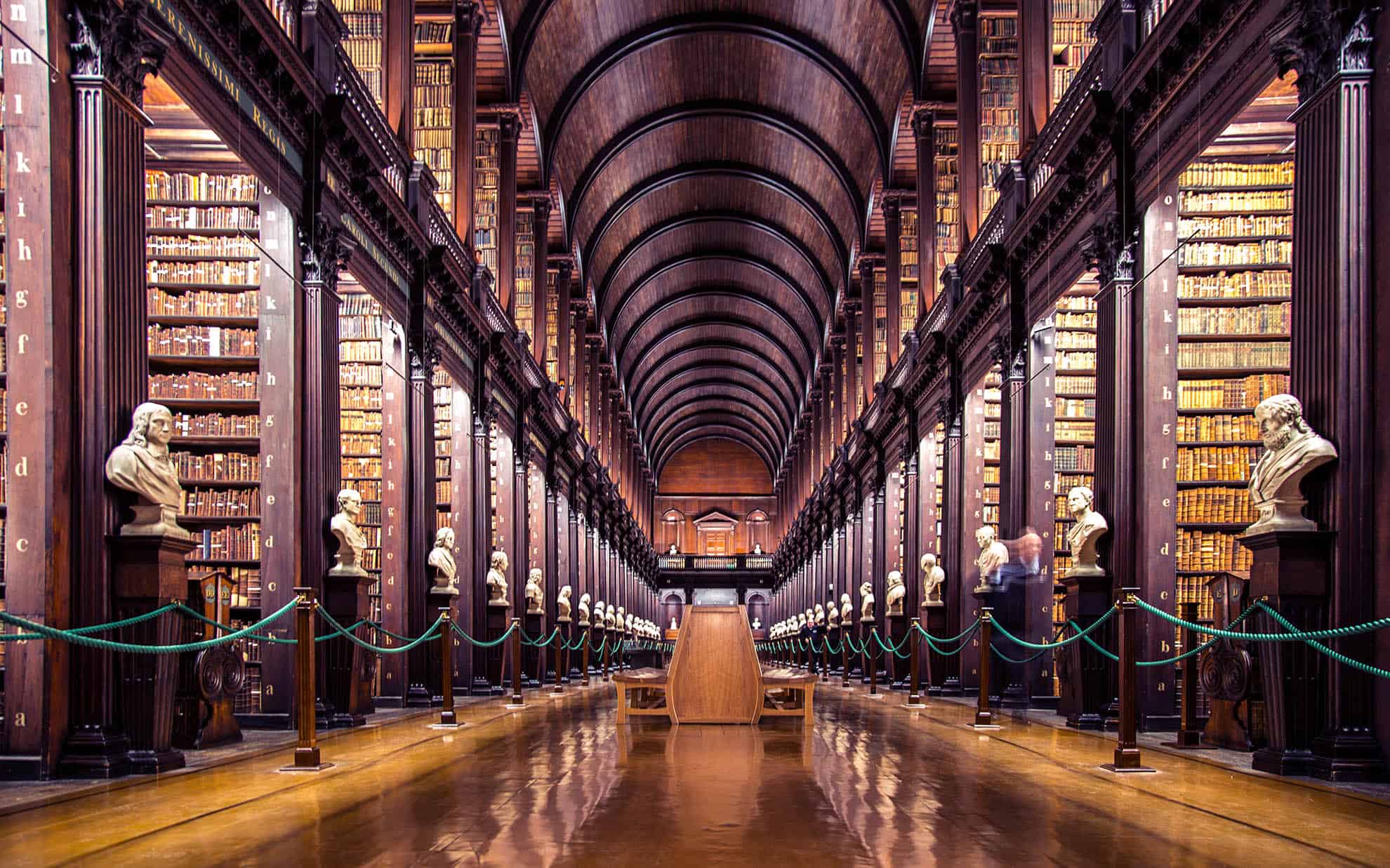
Founded in 1592, Trinity College is Ireland’s oldest and most prestigious university. You can take a guided tour of the historic campus and visit the Old Library to see the famous Book of Kells and the Long Room.
- Admission Fee: It is free to enter the Trinity College grounds. The main entrance is from College Green (near Dame Street)
- The Book of Kell Exhibit and access to the Long Hall €14 for adults €12 for students and seniors.
- Opening Hours: Monday through Saturday: 8:30 AM to 5:00 PM, Sunday: 9:30 AM to 5:00 PM (May through September). There are slight variations during other months.
- Book of Kells Website
- Take a guided tour: Fast-Track Book of Kells Ticket & Dublin Castle Tour
💡Book the earliest timeslot and arrive early (15/20 min before opening). Head straight to the Long Room and visit the Book of Kells afterwards. You will have the Library for yourself.
Note: The books in The Long Room have been removed from the shelves, and the Library itself will be closed for renovations from the end of 2023. For more information, visit the Old Library Redevelopment project website.
Guinness Storehouse
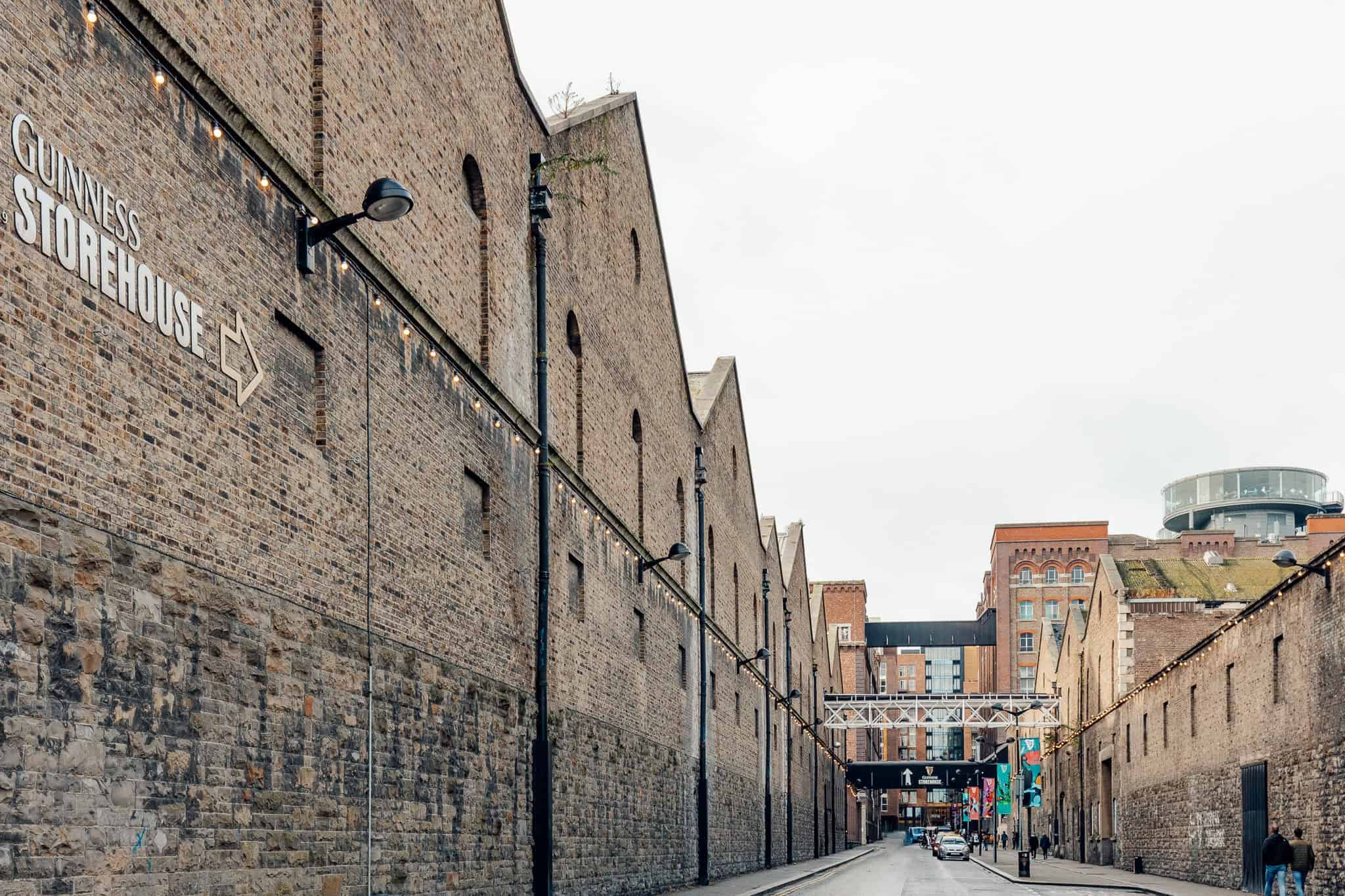
The Guinness Storehouse is one of Dublin’s most popular attractions, offering visitors a chance to learn about the history and production of Ireland’s most famous beer. The self-guided tour includes a free pint at the Gravity Bar, from where you’ll have the best panoramic views in Dublin.
- Admission Fee: €20 per adult & €18 for students/seniors (online discounts available) for a self-guided tour. Prices vary depending on the time and day of your visit. Prefer mid-week to avoid the crowd and get a cheaper ticket.
- Opening Hours: Daily from 9:30 AM to 7:00 PM (last entry at 5:00 PM).
- Guinness Storehouse Website
- Take a guided tour: Skip-the-Line: Guinness & Jameson Irish Experience Tour
💡At the end of your visit, don’t forget to head to the Gravity Bar on the seventh floor for breathtaking panoramic views of Dublin while savouring a complimentary pint of Guinness.
St Patrick Cathedral

This historic cathedral is the largest church in Ireland and is dedicated to the country’s patron saint. After a few years of renovation, the Cathedral is now open to visitors.
- Admission Fee: The St Patrick Cathedral’s garden is free. Entrance to the Cathedral is €11 for adults and €10 for students and seniors. You can buy a combined ticket with the Marsh’s library for €17.
- Opening Hours: Monday to Friday: 9:30 AM to 5:00 PM, Saturday: 9:00 AM to 6:00 PM, Sunday: 9:00 AM to 10:30 AM (for services), and 1:00 PM to 2:30 PM + 4:30 PM to 6:30 PM (visitors).
- St Patricks’ Cathedral Website
- Skip the ticket line
💡Attend the choral evensong service held daily at 5:30 PM for a memorable musical experience within the stunning cathedral ambience.
Dublin Castle

This impressive castle is right in the heart of Dublin’s city center. It was built in the 13th century and served as the seat of British power in Ireland for centuries. You can take a guided tour of the castle and learn about its rich history.
- Admission Fee to the State Apartment: €8 for adults, €6 for students/seniors. Family ticket €20.
- The Castle grounds & gardens are free.
- Opening Hours: Daily from 9:45 AM to 5:45 PM (Last entry at 5:15 PM)
- Dublin Castle Website
- Walking Tour ¦ Explore the Dark Side of Dublin. You will hear spooky stories, tales, and legends of the city. The walk will take you to Dublin Castle and a few other spots.
💡The Dubb Linn Gardens are a hidden gem to escape the hustle and bustle of the city. It is very quiet and not as crowded as the other capital’s parks. You can order snacks and soft drinks from the Chester Beatty Library Coffee shop.
Kilmainham Gaol

This historic jail was the site of many important events in Irish history, including the imprisonment and execution of many Irish nationalists.
- Admission Fee: €8 for adults, €6 for students/seniors.
- Opening Hours: Daily from 9:30 AM to 6:00 PM (last entry at 5:00 PM).
- Kilmainham Goal Website
💡Guided tours of the jail are available and are well worth your time if you want to learn about its fascinating history. Due to its popularity, it’s advisable to book tickets in advance to secure your preferred time slot.
Phoenix PArk
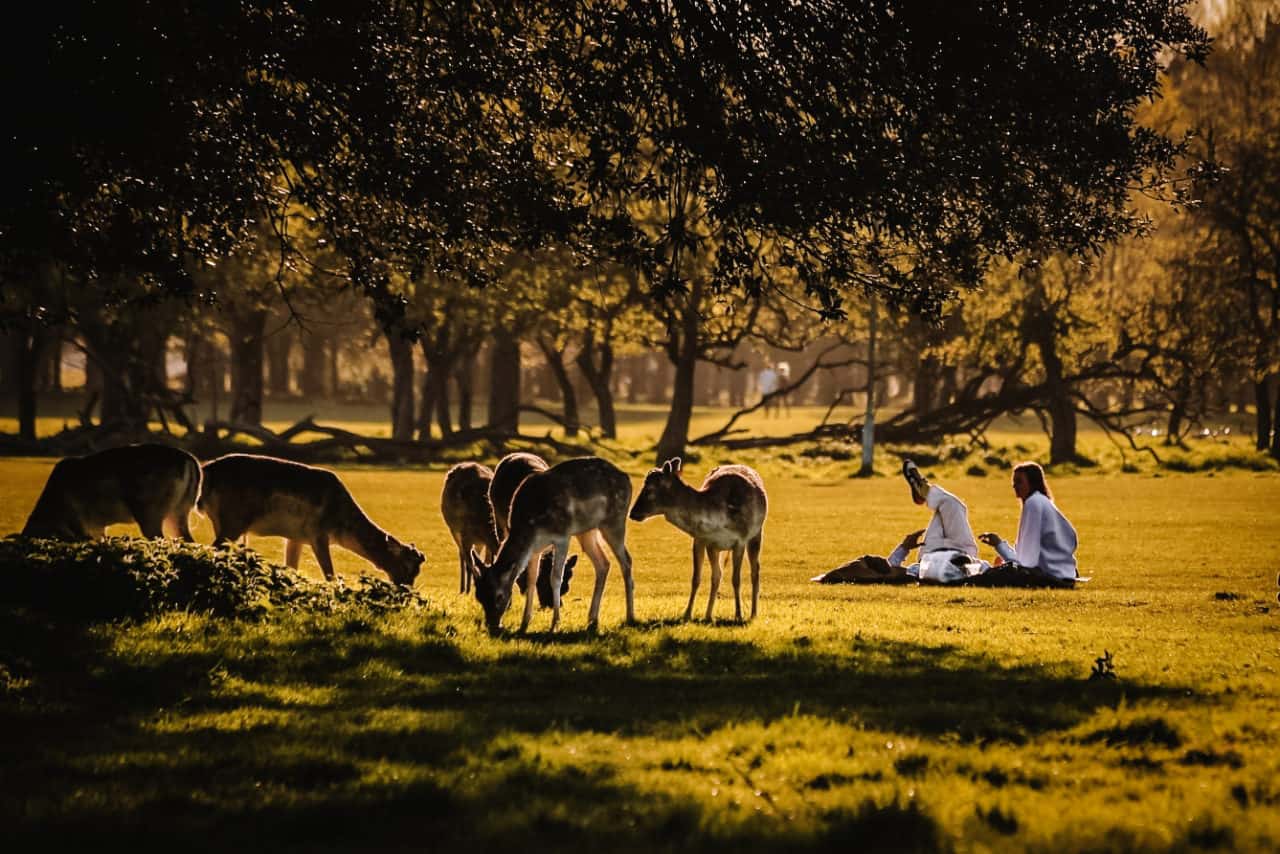
As one of the largest urban parks in Europe, Phoenix Park offers a peaceful escape from the bustle of the city. The park has numerous walking paths, gardens, and even a herd of wild deer. It is also home to the Dublin Zoo.
- Admission Fee: Phoenix Park is Free to visit.
- Opening Hours: 24 hours a day, 7 days a week, all year round.
- Hop-on/Hop-off Bus: Tour the streets of Dublin to Phoenix Park with this 24 to 48-hour Hop-on Hop-off bus ticket (€29 for 24 hours, €35 for 48 hours)
💡Once per year, you can join a walking tour with the Irish Wildlife Trust to learn more about fallow deer and their behaviour.
Dublin Go City All-Inclusive Pass
- More than 40 attractions included
- Available for 1-5 days
- Significant savings on multiple attractions
With the Dublin Go City All-Inclusive Pass, you gain access to a wide range of attractions, museums, tours, and experiences in Dublin, all for one upfront price. This pass is a smart choice for tourists who want to make the most of their visit by exploring multiple attractions on our list.
Here’s how it works: Simply choose the duration of your pass, from 1 to 5 days, print or download the pass on your phone, and show it at the entry of each attraction. Note some attractions will need a booking ahead.
Other popular Dublin spots include:
- Temple Bar: Known for its lively nightlife, it is a popular destination for visitors looking to experience Dublin’s pub culture. The area is home to numerous bars, restaurants, and music venues. The most famous place is the legendary red pub called the Temple Bar! Prices are probably the highest in the entire city, so if you’re on a budget, consider staying elsewhere. Grab a pint for the sake of it and move on to another pub… Check out the VCC, Foggy Dew, or Porterhouse in the area instead.
- The National Museum of Ireland: This renowned institution offers free admission, making it a must-visit for budget-conscious travellers. Explore fascinating exhibits showcasing archaeological treasures, ancient artefacts, and artistic masterpieces. Don’t miss the impressive collection of bog bodies, which provides a glimpse into Ireland’s ancient past.
👉 Psst! Find more Indoor activities to do when it rains in Dublin
- The Dublin Zoo – Located within Phoenix Park, the Dublin Zoo is a delightful attraction for animal lovers of all ages. With a diverse range of species from around the world, the zoo offers a captivating experience. Admission fees apply, but the opportunity to see majestic lions, playful penguins, and adorable primates is well worth it.
- Grafton Street – If you’re in the mood for some retail therapy or lively street performances, Grafton Street is the place to be. This bustling pedestrian street is lined with a variety of shops. Take a leisurely stroll, enjoy the vibrant atmosphere, and listen to talented street musicians serenading the crowds.
- St Stephen’s Green – Escape the hustle and bustle of the city and relax in the tranquil oasis of St. Stephen’s Green. This picturesque park offers a serene retreat with beautifully landscaped gardens, a peaceful lake, and charming walkways.
- The National Gallery of Ireland – Step into the world of art at the National Gallery of Ireland, which showcases an impressive collection of Irish and European masterpieces. Admission to the gallery is free, allowing art enthusiasts and casual visitors alike to admire renowned works by famous artists. From classical paintings to contemporary pieces, the gallery offers a diverse range of artistic styles and periods.
- The Jameson Distillery – Experience the essence of Irish whiskey at the Jameson Distillery. Take a guided tour to learn about the whiskey-making process, from the malting of barley to the final distillation. Discover the fascinating history of Jameson and enjoy a tasting session to savour the distinct flavours of this renowned Irish spirit. Insider tip: Consider booking your tour in advance to secure your preferred time slot.
- Christ Church Cathedral – Marvel at the stunning medieval architecture, intricate stained glass windows, and ornate interior. Take a guided tour to learn about the cathedral’s fascinating past and explore its hidden treasures, including the crypt, where ancient artefacts and historical exhibitions are displayed. Attend a choral performance or enjoy the panoramic views from the tower for an unforgettable experience. Don’t miss Marsh’s library if you’re in the area.
👉 Psst! Check out our dedicated article on the Best Whiskey Tours in Dublin in 2023


🏖️ Dublin BEACHES
Dublin may not be the first place that comes to mind when you think of beaches, but the city has several beautiful coastal spots worth visiting. From sandy stretches to rocky coves, there are plenty of options for beach lovers in Dublin.
Some of the most popular beaches in the area include Portmarnock, a long sandy beach located just north of the city, and Killiney Beach, a secluded and picturesque spot that offers stunning views of Dublin Bay.
Other great options include Sandymount Strand, a vast stretch of sand perfect for a relaxing stroll, and Dollymount Strand, a popular spot for windsurfing and kiteboarding. Finally, Burrow Beach is another lovely beach located in Sutton, a suburb on the north side of Dublin. It’s a hidden gem that’s less well-known than some other beaches in the area, making it a great spot to escape the crowds.
🏰 Dublin CASTLES
Dublin is home to several castles that offer visitors a glimpse into the city’s rich history and heritage. One of the most famous is the Dublin Castle, which dates back to the 13th century and was once the seat of British power in Ireland. Today, the castle is open to the public and houses several museums, including the Chester Beatty Library and the Revenue Museum.
Another notable castle is Malahide Castle, a beautiful medieval castle located just north of Dublin. The castle features ornate period furnishings, an impressive collection of portraits and art, and picturesque gardens. Visitors can take guided tours of the castle and explore its history and architecture.
Other castles in Dublin include Drimnagh Castle, a medieval tower house that is open for tours on certain days, and Swords Castle, a 13th-century fortress that played a significant role in Ireland’s history.
If you want to stay in a castle in Ireland, near Dublin, the Clontarf Castle is a great choice.
🏝 Dublin ISLANDS
That’s a funny one! Who would even think about visiting islands when travelling to Dublin? Due to its location near the Irish Sea, Dublin is surrounded by several beautiful islands, each with its unique charm.
One of the most well-known is Dalkey Island, just a short boat ride from the mainland. This small island is home to the ruins of an ancient church, a Martello tower, and a variety of wildlife, including seals and seabirds. Another island worth visiting is Ireland’s Eye, located off the coast of Howth.
This stunning nature reserve features several walking trails, sandy beaches, and a diverse array of flora and fauna. Other islands off the coast of Dublin include Lambay Island, which is privately owned but can be viewed from afar, and Bull Island, which is connected to the mainland via a bridge in Clontarf and boasts a beautiful beach and nature reserve where you can go birdwatching or kitesurfing on windy days.
👉 Click here to read about the top islands in Ireland that you cannot miss!!
What are the best neighbourhoods in Dublin?
Dublin is a large city with many different neighbourhoods. Each has its own unique character, with a diverse range of attractions, places to stay and eat, specific activities, and hidden gems to explore.
- City Centre – Mostly famous Temple Bar, Trinity College, and St Stephen’s Green. The area around Dame St is particularly busy with lots of cafes, restaurants, and pubs. It’s an excellent place for those looking to go pub crawling, try local beers, or even listen to traditional Irish music. During the day, it is also home to Ireland’s oldest and most prestigious university, Trinity College, as well as the bustling Grafton Street shopping district, filled with high-end stores, street performers, and cafes.
- Smithfield: Located just north of the River Liffey, Smithfield is a trendy neighbourhood that has undergone significant revitalisation in recent years. Its main attraction is the lively Smithfield Square, which hosts various events throughout the year. Nearby, you will find the Jameson Distillery on Bow St., which offers whiskey tours and tastings.
- Stoneybatter: Known for its quaint streets and colourful houses, Stoneybatter is a charming neighbourhood just west of the city centre. It is a very local place filled with independent shops, cafes, and restaurants. You can explore the area’s historical attractions, such as the 18th-century St. Michan’s Church and its famous crypts or the National Museum of Decorative Arts & History.
- The Liberties: Located south of the River Liffey, The Liberties is one of Dublin’s oldest neighbourhoods and has a rich history dating back to medieval times. Visitors can explore landmarks such as the Christ Church Cathedral, St. Patrick’s Cathedral, and the Guinness Storehouse or wander down the narrow streets lined with traditional pubs. The area is also home to the Teeling Whiskey Distillery, which offers tours and tastings of its award-winning spirits.
- Rathmines – Located just south of the city centre, Rathmines is a bustling part of the city with a lively atmosphere. It’s a popular area for students and young professionals, with plenty of bars, restaurants, and cafes to explore. The main street is home to many unique shops and boutiques, and there’s a cinema and a theatre for entertainment.
- Portobello – Portobello is a charming area located just north of the Grand Canal. It’s known for its picturesque streets lined with colourful houses, as well as its trendy cafes and restaurants. The neighbourhood is also home to the Portobello Market, which takes place every Saturday and features a range of stalls selling everything from vintage clothing to handmade crafts.
- Sandymount – Sandymount is a picturesque coastal village located just out of Dublin city centre. It’s a popular spot for a leisurely walk along the beach or to the Poolbeg Lighthouse. From here, you will have the best views of the famous Poolbel Power Station towers that locals see as the symbol of the city.
- Ballsbridge – Ballsbridge is an affluent neighbourhood known for its grand Georgian houses and leafy streets, as well as its proximity to the Aviva Stadium, which hosts regional and international Rugby matches. The area is home to many upscale restaurants and bars, as well as Herbert Park, a popular spot for picnics or playing Frisbee.


Best Foods to Eat in Ireland
Irish Stew – This classic Irish dish is made with lamb or beef, potatoes, carrots, onions, and herbs. It’s the ultimate comfort food and perfect for warming up on a chilly day. However, Irish stew is not the type of food you find in restaurants where locals go… Irish Stew is typically found in the more “touristy” pubs, let’s be honest.
One popular spot for Irish stew is The Brazen Head, which claims to be Ireland’s oldest pub, dating back to 1198. Another option is O’Neill’s Bar, where you can also see Irish dancing on some evenings. Other pubs and restaurants in the Dublin area that are known for their Irish stew include Johnny Fox’s, and Gallagher’s Boxty House.
💡If you want to escape touristy places, I recommend ordering a Beef and Guinness Pie as an alternative. One of my favourites is at Ryan’s restaurant, just outside Phoenix Park.
Seafood Chowder: Ireland’s coastline is a seafood lover’s paradise, and seafood chowder is a must-try dish. Made with a creamy base, potatoes, fresh seafood, and herbs, this hearty soup is a staple in many coastal towns and restaurants in Dublin. It will always be served with some freshly baked Irish soda bread and butter. In my opinion, the best seafood chowder is at the Restaurant The Bank on Dame Street. Alternatively, the Brass Monkey in Howth also serves a delicious one.
Irish Cheese – Ireland produces some of the world’s best cheese, including the famous Cashel Blue and the creamy Brie-like Durrus. To find all the local Irish cheese, head to Sheridan’s cheesemonger or the shop Fallon & Byrne. Both are located near Grafton St.
Black Pudding – A traditional Irish sausage made with pig’s or cow’s blood, cereals or grains, and spices. It is best served as part of an Irish breakfast along with Irish sausages, eggs, and toast.
Irish Coffee is a classic Irish drink made with hot coffee, Irish whiskey, sugar, and whipped cream. It’s the perfect way to warm up on a cold day, although it’s not something locals drink… Some bars and restaurants will have it on the menu; if not, ask the bartender.
Something fun to do while in Dublin, is to take an Irish Coffee Masterclass to learn the art of combining rich Irish whiskey, smooth coffee, and velvety cream! This hands-on experience will not only satisfy your taste buds but will also offer insights into the cultural significance of this beloved beverage.



Dublin Travel: Know before you go
💰Currency: Euro
🗣️Language: English and Irish Gaelic are the official languages of Ireland. Due to the country’s diverse population, you may also hear other languages, such as Polish or Brazilian.
🛂 Ireland Visa: Most travellers from the US, Canada, Australia, and many European countries do not need a visa to visit the Republic of Ireland for up to 90 days. Check if you need an Irish travel visa here.
🔌Electricity Socket: Ireland uses Type G sockets, which have three rectangular pins. If you’re from a country that uses a different type of plug, you’ll need an adapter.
☎️ Ireland SIM Card: If you want to use your phone in Ireland, you’ll need to get a pre-paid SIM card. Lyca Mobile or Free offer good deals, but I prefer Airalo eSIM when I travel abroad. It’s easy to install and you don’t have to go to a shop (everything can be done online, from home!). If you are from the European Union, you can use your roaming allowance
What’s the best time to visit Dublin?
Busy Season: The busiest time to visit Ireland is during the summer months, from June to August. The weather is mild, and there are plenty of outdoor activities to enjoy. However, this is also the most expensive time to travel, and popular destinations can be crowded.
The month of March is also a very crowded period with hundreds of thousands of people gathering in the city for the St Patrick’s parade and celebrations.
Shoulder Season: The shoulder season is the best time to visit Ireland, with mild weather and fewer crowds. It runs from April to May and from September to October.
Slow Season: The slow season in Ireland runs from November to March, when you can find the best deals on travel and accommodations, except during the St Patrick’s holiday, which tends to see prices skyrocket. While the days are shorter and colder, in my opinion, Ireland is still worth visiting in winter.
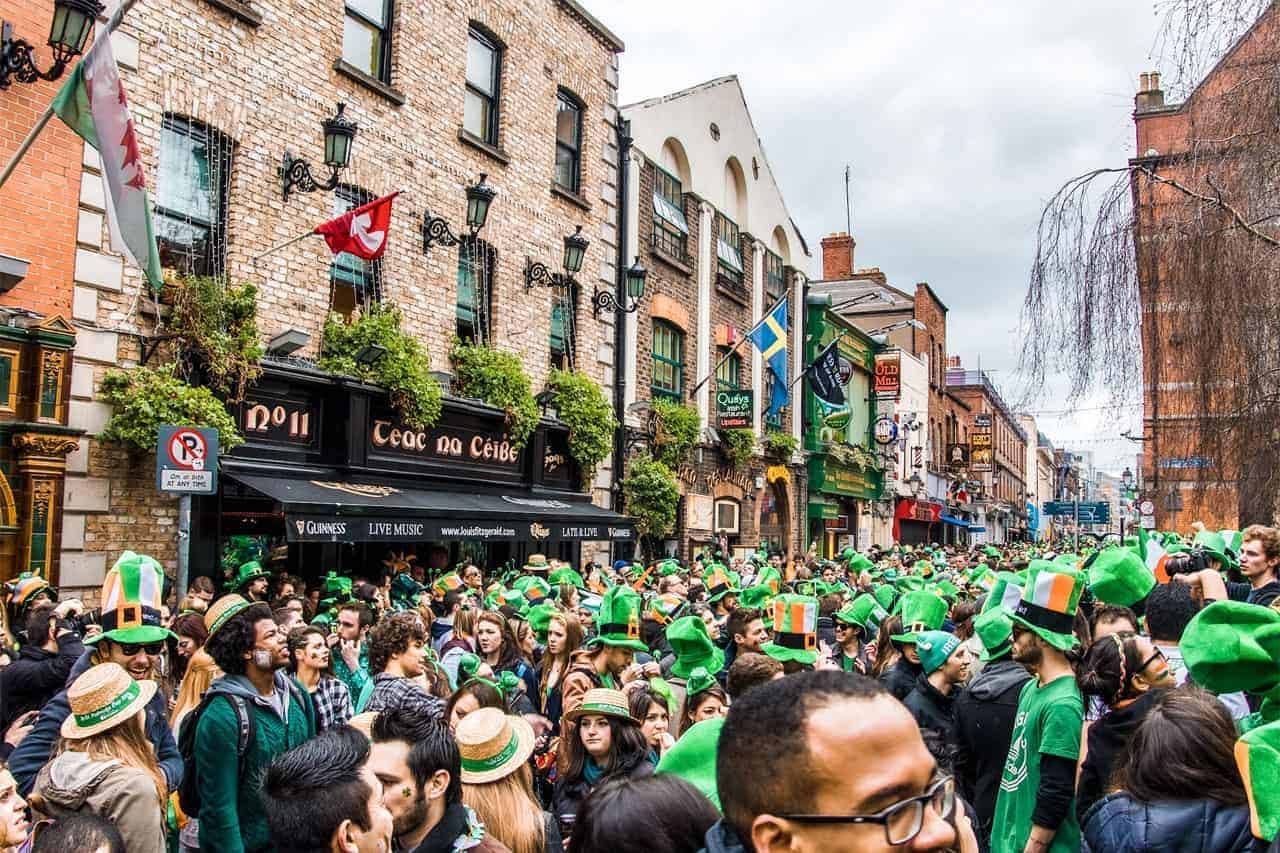
What are the best holidays to visit Dublin?
St. Patrick’s Day (March 17th) – Celebrated worldwide, St. Patrick’s Day is Ireland’s national holiday and features parades, music, and lots of green.
Halloween (October 31st) – Halloween has its roots in Celtic culture, and Ireland is a great place to dress up and celebrate. The streets tend to get very busy with house parties and fireworks on the night of Halloween. In residential areas, kids dress up and go trick-or-treating in their neighbourhoods. The Bram Stoker Festival takes over the city annually, with many outdoor installations, classic film shows and parades.
Christmas (December) – Throughout the holiday season, Dublin comes alive with festive markets, street lights, and many Christmas parties. Dublin is buzzing throughout December, making it a great time to party.
Dublin Fringe Festival (September) – This annual arts festival takes place in September. It features a wide range of performances, exhibitions, and events.
Dublin LGBTQ+ Pride Festival (June) – This festival celebrates Dublin’s LGBTQ+ community with a parade, parties, and events throughout the city.
Bloomsday Festival (June) – Held on June 16, this festival celebrates the life and work of James Joyce and his famous novel Ulysses, which is set in Dublin.
Dublin Marathon (in October) – This annual marathon attracts thousands of runners from around the world.
Taste of Dublin (June): This is a foodie’s dream come true, a festival showcasing the best of Dublin’s culinary scene. It’s not to be missed!
What to pack for a trip to Dublin?
✅ Warm and Waterproof Clothing
Ireland’s weather is famously unpredictable! Pack a waterproof jacket and sturdy shoes, even in summer. Layer with a cosy sweater, fleece, or light puffer jacket for chilly days.
✅ Comfortable Walking Shoes
Cobblestone streets and hilly trails call for comfy shoes. Planning to hike? Choose ankle-supporting boots for Ireland’s rocky, uneven paths.
✅ Power Adapter
Ireland uses the Type G plug, so bring the correct adapter to keep your devices charged.
✅ Cash and Credit Cards
Most places accept cards, but having cash is handy. If you’re renting a car, the driver must have a valid personal credit card.
❌ Skip the Umbrella
Irish rain often comes with strong winds—umbrellas don’t stand a chance! Opt for a waterproof hood instead.
🔗 Need the complete list? Check out our Ultimate Ireland Packing List or download our 7-page e-guide, which you can print or use on your phone to tick off items as you go!
What’s the best travel insurance for Ireland?
While Ireland is a perfectly safe country to visit, travelling in general opens you to vulnerabilities that you simply don’t have at home, such as missed flights, lost luggage, or accidents.
It is important to always have valid travel insurance covering everyone, as unexpected events and incidents can occur during travel. We recommend purchasing travel insurance beforehand, as it is always a worthwhile investment. If it isn’t for financial protection, do it for your peace of mind.
👉 Click on any of the links below to get a free quote on your policy!
✅ VisitorsCoverage: Ideal for international travellers, offering customizable plans for medical coverage, trip protection, and more.
✅ Ekta Travel Insurance: This is Affordable and comprehensive, perfect for adventure seekers needing extra coverage for outdoor activities.
Are you going somewhere else?
Ireland is divided into four distinct regions: Leinster, Munster, Ulster, and Connacht. Each region has its unique character, with a diverse range of attractions, activities, and hidden gems to explore.
Dublin is located in the Leinster region, but you can easily take a day trip to the other side of the country! This is how small Ireland is 🙂

